tow HONDA PASSPORT 2001 2.G Owners Manual
[x] Cancel search | Manufacturer: HONDA, Model Year: 2001, Model line: PASSPORT, Model: HONDA PASSPORT 2001 2.GPages: 317, PDF Size: 4.85 MB
Page 19 of 317
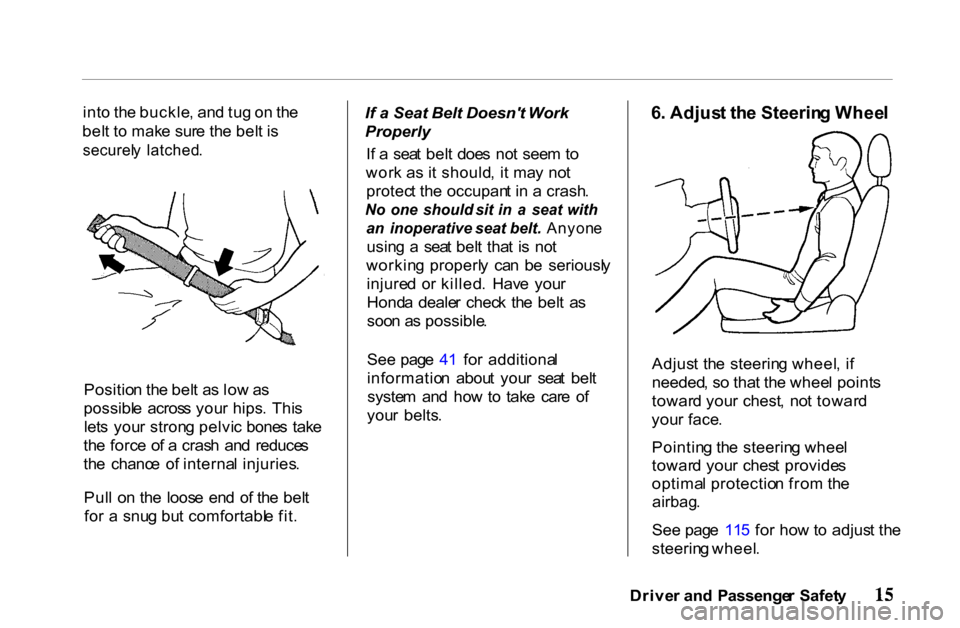
int
o th e buckle , an d tu g o n th e
bel t t o mak e sur e th e bel t i s
securel y latched .
Positio n th e bel t a s lo w a s
possibl e acros s you r hips . Thi s
let s you r stron g pelvi c bone s tak e
th e forc e o f a cras h an d reduce s
th e chanc e o f interna l injuries .
Pul l o n th e loos e en d o f th e bel t
fo r a snu g bu t comfortabl e fit . If
a Seat Belt Doesn't Work
Properly
I f a sea t bel t doe s no t see m to
wor k a s i t should , i t ma y no t
protec t th e occupan t i n a crash .
No one should sit in a seat with
a n inoperative seat belt. Anyon e
usin g a sea t bel t tha t i s no t
workin g properl y ca n b e seriousl y
injure d o r killed . Hav e you r
Hond a deale r chec k th e bel t a s
soo n a s possible .
See pag e 4 1 fo r additiona l
informatio n abou t you r sea t bel t
syste m an d ho w to tak e car e o f
you r belts .
6
. Adjus t th e Steerin g Whee l
Adjus t th e steerin g wheel , i f
needed , s o tha t th e whee l point s
towar d you r chest , no t towar d
you r face .
Pointin g th e steerin g whee l
towar d you r ches t provide s
optima l protectio n fro m th e
airbag .
See pag e 11 5 fo r ho w to adjus t th e
steerin g wheel .
Drive r an d Passenge r Safet y
Page 35 of 317
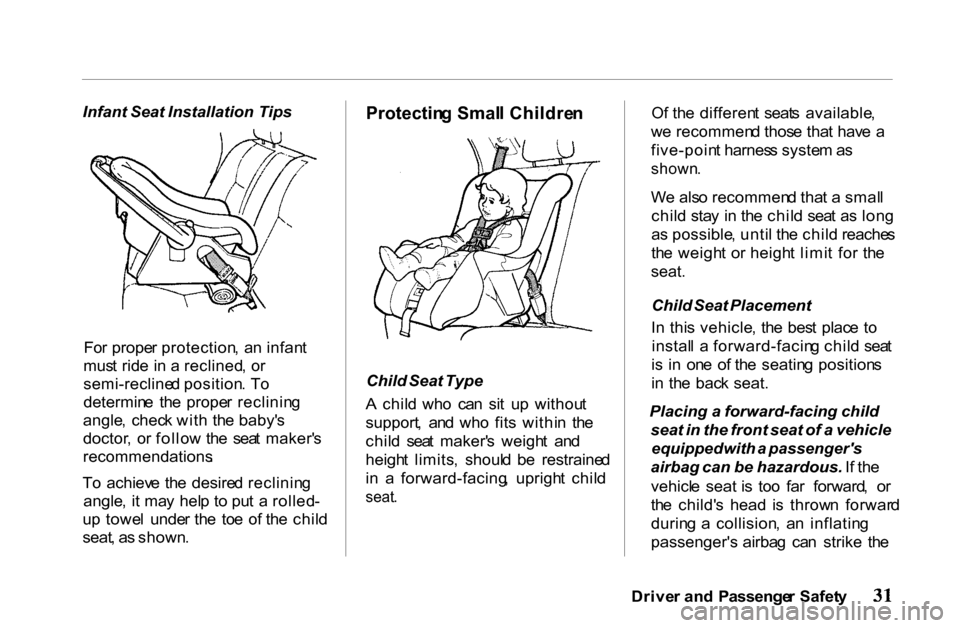
Infant
Seat Installation Tips
Fo r prope r protection , a n infan t
mus t rid e i n a reclined , o r
semi-recline d position . T o
determin e th e prope r reclinin g
angle , chec k wit h th e baby' s
doctor , o r follo w th e sea t maker' s
recommendations .
T o achiev e th e desire d reclinin g
angle , i t ma y hel p t o pu t a rolled -
u p towe l unde r th e to e o f th e chil d
seat , a s shown .
Protectin
g Smal l Childre n
Child Seat TypeA child wh o ca n si t u p withou t
support , an d wh o fit s withi n th e
chil d sea t maker' s weigh t an d
heigh t limits , shoul d b e restraine d
i n a forward-facing , uprigh t chil d
seat .
O
f th e differen t seat s available ,
w e recommen d thos e tha t hav e a
five-poin t harnes s syste m as
shown .
W e als o recommen d tha t a smal l
chil d sta y i n th e chil d sea t a s lon g
a s possible , unti l th e chil d reache s
th e weigh t o r heigh t limi t fo r th e
seat.
Child Seat Placement
I n thi s vehicle , th e bes t plac e t o
instal l a forward-facin g chil d sea t
i s i n on e o f th e seatin g position s
i n th e bac k seat.
Placing a forward-facing child
seat in the front seat of a vehicle
equipped with a passenger's
airbag can be hazardous. If th e
vehicl e seat is to o fa r forward , o r
th e child' s head is throw n forwar d
durin g a collision , a n inflatin g
passenger's airbag ca n strike the
Drive r an d Passenge r Safet y
Page 66 of 317

th
e syste m repaire d if th e ligh t
doe s no t com e o n whe n th e ke y i s
turne d t o th e "ON " positio n
withou t th e engin e runnin g o r
whe n th e parkin g brak e is set .
Thi s ligh t doe s no t eliminat e th e
nee d fo r brak e inspectio n an d
maintenance . Th e brak e flui d
leve l mus t b e checke d regularly .
Se e th e maintenanc e sectio n o f
thi s manua l fo r othe r brak e
checks .
I f th e ligh t remain s o n afte r
engin e star t u p wit h th e parkin g
brak e released , o r come s o n
durin g operatio n o f th e vehicle , i t
ma y mea n tha t ther e is somethin g
wron g wit h th e brak e system .
What to do?
1 . Chec k t o se e if th e parkin g
brak e ha s bee n full y released .
2
. I f i t has , pul l of f th e roa d an d
sto p carefully . Remembe r that :
Stoppin g distance s ma y b e
longer . Yo
u ma y hav e t o pus h
harde r o n th e pedal .
Th e peda l ma y g o dow n
farthe r tha n normal .
3 . Hav e th e vehicl e towe d t o th e
neares t Hond a deale r fo r
repair .
D o no t continu e t o driv e wit h th e
brak e syste m ligh t on . Ther e ma y
b e a seriou s proble m wit h th e
brakin g system . Drivin g unde r
thi s conditio n is hazardou s an d
coul d lea d t o a n accident .
Th e brak e syste m ligh t doe s no t
indicat e tha t th e parkin g brak e i s
full y set . Whe n applyin g th e
parkin g brake , alway s pul l i t u p a s
fa r a s possible .
Hig
h Bea m
Th e headligh t hig h bea m indicato r
light s u p whe n th e headlight s ar e
o n hig h beam .
Chargin g Syste m
Thi s ligh t shoul d com e o n whe n
th e ke y i s turne d t o th e "ON "
positio n an d th e alternato r i s no t
charging . Th e ligh t ma y sta y o n a t
engin e idle ; however , i t shoul d g o
of f an d sta y of f abov e th e norma l
engin e idl e speed . I f th e ligh t
come s o n whil e driving , th e
chargin g syste m shoul d b e
checke d a t onc e s o th e batter y wil l
no t completel y discharge . Sto p th e
engine , an d chec k fo r a broke n
driv e belt . I f i t i s broken , o r i f th e
driv e bel t i s no t responsibl e fo r
th e trouble , hav e you r Hond a
deale r inspec t an d correc t th e
fault . I f th e driv e bel t i s broken ,
Instrument s an d Control s
Page 68 of 317

If
you keep driving with the
malfunction indicator lamp on,
you can damage your vehicle's
emissions controls and engine.
Those repairs may not be covered
by your vehicle's warranties.
Reduce d Powe r
Indicato r
Thi s ligh t come s o n fo r a fe w
seconds when yo u tur n th e ke y t o
th e "ON " positio n
I f i t come s o n a t an y othe r time , i t
indicate s tha t ther e is a proble m in
th e throttl e "drive-by-wire "
system . Wit h th e ligh t on , you r
vehicl e goes into "lim p home "
mod e — the engin e run s o n thre e
cylinders , an d th e accelerato r
peda l n o longe r control s engin e
speed .
A
s soo n a s i t i s safe , pul l of f th e
roa d an d tur n of f th e engine .
Restar t th e engin e to rese t th e
system . I f th e ligh t remain s on , o r
come s o n agai n whil e driving ,
hav e th e vehicl e towe d to you r
Hond a deale r fo r repair .
Tur n Signa l
Indicator s
A gree n ligh t flashin g o n th e
instrumen t pane l let s yo u kno w
tha t th e fron t an d rea r tur n signa l
light s ar e working . I f th e ligh t
stay s o n an d doe s no t flash , chec k
fo r a burne d ou t bulb . I f ther e is
n o ligh t whe n th e leve r i s moved ,
chec k th e fus e an d bulb .
Wheneve r th e Hazar d Warnin g
Flashe r Switc h is on , bot h tur n
signal s wil l flash . Lo
w Fue l Indicato r
Thi s ligh t come s o n whe n th e tan k
become s nearl y empty . Fil l u p th e
tan k a s soo n a s possible .
I f th e lo w fue l indicato r ligh t
come s o n whe n th e fue l tan k is
no t nearl y empty , hav e th e fue l
tan k sensin g uni t an d relate d
component s inspecte d an d
repaire d b y you r Hond a dealer .
Drivin g o n a roa d wit h man y
shar p curve s ma y caus e th e fue l
indicato r ligh t t o blin k
intermittently . Thi s i s normal .
Lo w Oi l
Pressur e Indicato r
Thi s ligh t i s designe d to com e o n
t o provid e a "bul b check " whe n
th e ke y is turne d to th e "ON "
position , bu t shoul d g o ou t afte r
Instrument s an d Control s
NOTIC
E
REDUCE D
POWE R
Page 72 of 317
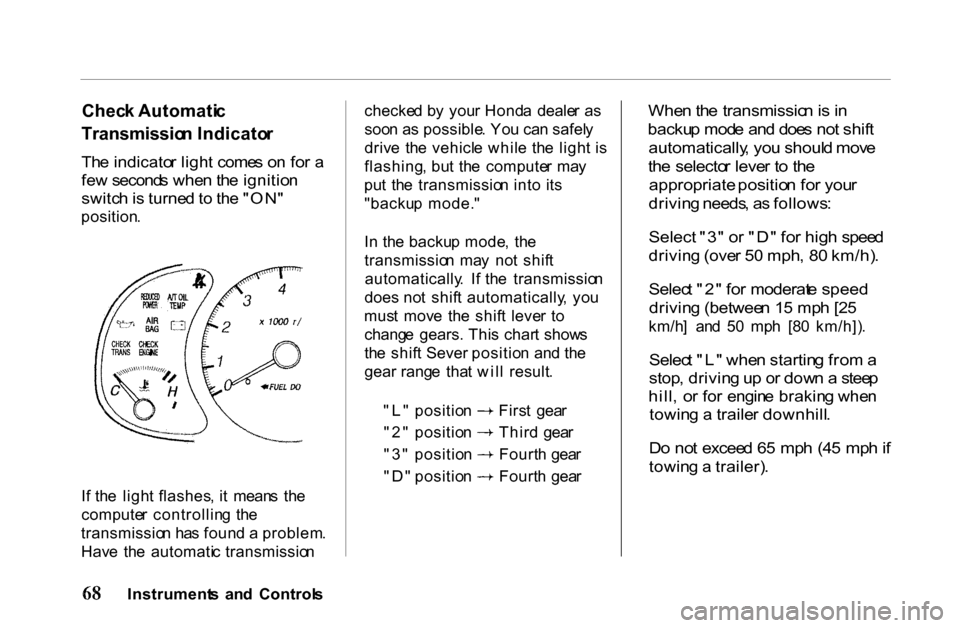
Chec
k Automati c
Transmissio n Indicato r
Th e indicato r ligh t come s o n fo r a
fe w second s whe n th e ignitio n
switc h is turne d to th e "ON "
position .
I f th e ligh t flashes , i t mean s th e
compute r controllin g th e
transmissio n ha s foun d a problem .
Hav e th e automati c transmissio nchecke
d b y you r Hond a deale r a s
soo n a s possible . Yo u ca n safel y
driv e th e vehicl e whil e th e ligh t i s
flashing , bu t th e compute r ma y
pu t th e transmissio n int o it s
"backu p mode. "
I n th e backu p mode , th e
transmissio n ma y no t shif t
automatically . I f th e transmissio n
does not shif t automatically , yo u
mus t mov e th e shif t leve r t o
chang e gears. This char t show s
th e shif t Sever positio n an d th e
gear rang e tha t wil l result . "L
" positio n Firs t gea r "2
" positio n Thir d gea r "3
" positio n Fourt h gea r "D
" positio n Fourt h gea r
Whe
n th e transmissio n is i n
backu p mod e an d doe s no t shif t
automatically , yo u shoul d mov e
th e selecto r leve r t o th e
appropriate position fo r you r
drivin g needs , a s follows :
Select "3" o r "D " fo r hig h spee d
drivin g (ove r 5 0 mph , 8 0 km/h) .
Selec t "2 " fo r moderat e speed
drivin g (betwee n 1 5 mp h [2 5
km/h ] an d 5 0 mp h [8 0 km/h]) .
Selec t "L " whe n startin g fro m a
stop , drivin g u p o r dow n a stee p
hill , o r fo r engin e brakin g whe n
towin g a traile r downhill .
D o no t excee d 6 5 mp h (4 5 mp h if
towin g a trailer) .
Instrument s an d Control s
Page 81 of 317
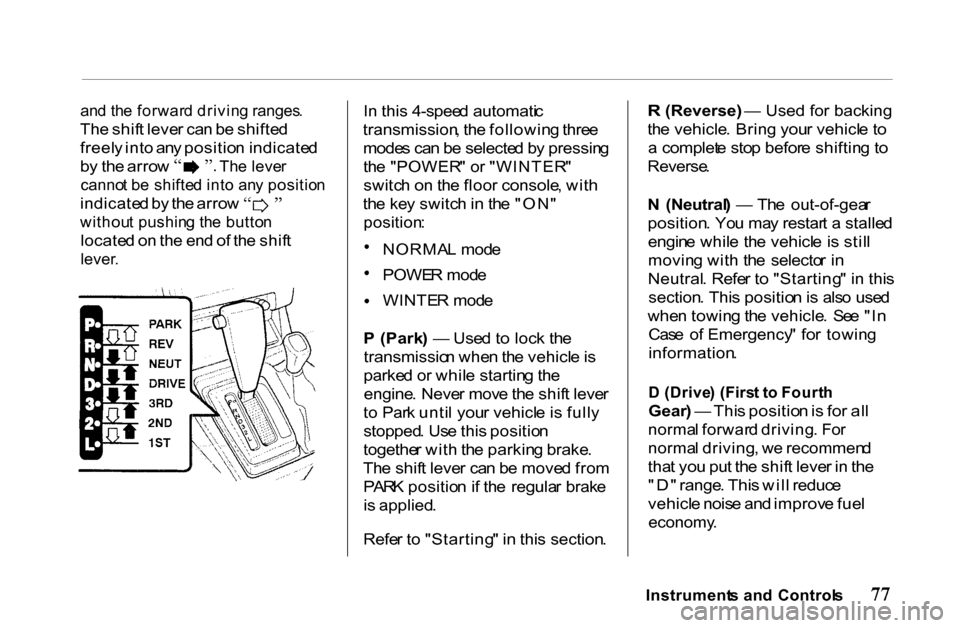
an
d th e forwar d drivin g ranges .
Th e shif t leve r ca n b e shifte d
freel y int o an y positio n indicate d b
y th e arro w
Th e leve r
canno t b e shifte d int o an y positio n
indicate
d b y th e arro w
withou t pushin g th e butto n
locate d o n th e en d o f th e shif t
lever .
I
n this 4-spee d automati c
transmission , th e followin g thre e
mode s ca n b e selecte d b y pressin g
th e "POWER " o r "WINTER "
switc h o n th e floo r console , wit h
th e ke y switc h in th e "ON "
position :
NORMA
L mod e POWE
R mod e WINTE
R mod e
P (Park ) — Use d t o loc k th e
transmissio n whe n th e vehicl e is
parke d o r whil e startin g th e
engine . Neve r mov e th e shif t leve r
t o Par k unti l you r vehicl e is full y
stopped . Us e this positio n
togethe r wit h th e parkin g brake .
Th e shif t leve r ca n b e move d fro m
PAR K positio n if th e regula r brak e
i s applied .
Refe r t o "Starting " i n thi s section .
R (Reverse) — Used for backing
the vehicle . Brin g you r vehicl e t o
a complet e sto p befor e shiftin g to
Reverse .
N (Neutral ) — Th e out-of-gea r
position . Yo u ma y restar t a stalle d
engin e whil e th e vehicl e is stil l
movin g wit h th e selecto r i n
Neutral . Refe r t o "Starting " i n thi s
section . Thi s positio n is als o use d
whe n towin g th e vehicle . Se e "I n
Cas e o f Emergency " fo r towin g
information .
D (Drive ) (Firs t t o Fourt h
Gear ) — Thi s positio n is fo r al l
norma l forwar d driving . Fo r
norma l driving , w e recommen d
tha t yo u pu t th e shif t leve r i n th e
"D " range . Thi s wil l reduc e
vehicl e nois e an d improv e fue l
economy .
Instrument s an d Control s
Page 83 of 317
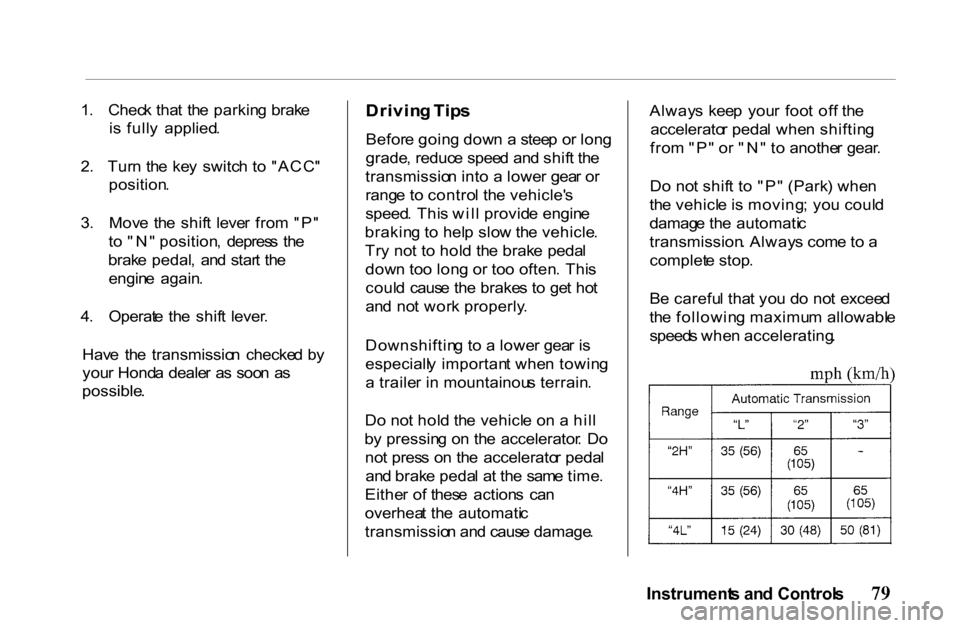
1
. Chec k tha t th e parkin g brak e
i s full y applied .
2 . Tur n th e ke y switc h t o "ACC "
position .
3 . Mov e th e shif t leve r fro m "P "
t o "N " position , depres s th e
brak e pedal , an d star t th e
engin e again .
4 . Operat e th e shif t lever .
Hav e th e transmissio n checke d b y
you r Hond a deale r a s soo n a s
possible .
Drivin
g Tip s
Befor e goin g dow n a stee p o r lon g
grade , reduc e spee d an d shif t th e
transmissio n int o a lowe r gea r o r
rang e t o contro l th e vehicle' s
speed . Thi s wil l provid e engin e
brakin g t o hel p slo w th e vehicle .
Tr y no t t o hol d th e brak e peda l
dow n to o lon g o r to o often . Thi s
coul d caus e th e brake s t o ge t ho t
an d no t wor k properly .
Downshiftin g t o a lowe r gea r i s
especiall y importan t whe n towin g
a traile r i n mountainou s terrain .
D o no t hol d th e vehicl e o n a hil l
b y pressin g o n th e accelerator . D o
no t pres s o n th e accelerato r peda l
an d brak e peda l a t th e sam e time .
Eithe r of thes e action s ca n
overhea t th e automati c
transmissio n an d caus e damage . Alway
s kee p you r foo t of f th e
accelerato r peda l whe n shiftin g
fro m "P " o r "N " t o anothe r gear .
D o no t shif t t o "P " (Park ) whe n
th e vehicl e is moving ; yo u coul d
damag e th e automati c
transmission . Alway s com e t o a
complet e stop .
B e carefu l tha t yo u d o no t excee d
th e followin g maximu m allowabl e
speed s whe n accelerating .
Instrument s an d Control s
Page 98 of 317

The
y ar e mos t effectiv e whe n yo u
adjus t the m s o th e bac k o f th e
occupant' s hea d rest s agains t th e
cente r o f th e restraint . A talle r
perso n shoul d adjus t th e restrain t
a s hig h a s possible . Pus
h th e loc k kno b t o unloc k th e
hea d restraint . Mov e th e restrain t
u p o r dow n a s required .
Adjus t th e hea d restrain t befor e
yo u star t driving . Tryin g t o adjus t
i t whil e drivin g coul d caus e yo u
t o los e contro l o f th e vehicle .
T o remov e a hea d restrain t fo r
cleanin g o r repair , pus h th e
releas e butto n an d pul l th e
restrain t ou t o f th e seat-back .
Rea
r Sea t
Th e rea r sea t ca n b e folde d
forwar d t o provid e additiona l
carg o area .
Foldin g
1 . Pul l th e stra p towar d th e
outsid e o f th e sea t an d fol d th e
sea t cushio n up .
Seat s
Pul
l th e
strap .
Pus
h t o
releas e
th e lock .
Page 159 of 317
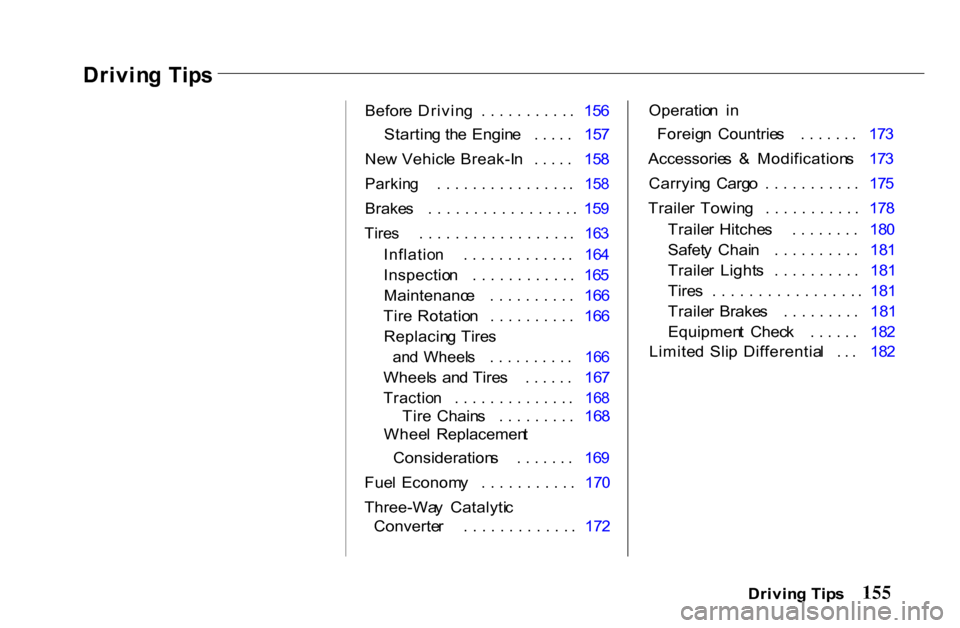
Drivin
g Tip s
Before Drivin g .......... . 15 6
Startin g th e Engin e .... . 15 7
Ne w Vehicl e Break-I n .... . 15 8
Parkin g ............... . 15 8
Brake s ................ . 15 9
Tire s ................. . 16 3
Inflatio n ............ . 16 4
Inspectio n ........... . 16 5
Maintenanc e ......... . 16 6
Tir e Rotatio n ......... . 16 6
Replacin g Tire s
an d Wheel s ......... . 16 6
Wheel s an d Tire s ..... . 16 7
Tractio n ............. . 16 8
Tir e Chain s ........ . 16 8
Whee l Replacemen t
Consideration s ...... . 16 9
Fue l Econom y .......... . 17 0
Three-Wa y Catalyti c
Converte r ............ . 17 2 Operatio
n i n
Foreig n Countrie s ...... . 17 3
Accessorie s & Modification s 17 3
Carryin g Carg o .......... . 17 5
Traile r Towin g .......... . 17 8
Traile r Hitche s ....... . 18 0
Safet y Chai n ......... . 18 1
Traile r Light s ......... . 18 1
Tire s ................ . 18 1
Traile r Brake s ........ . 18 1
Equipmen t Chec k ..... . 18 2
Limite d Sli p Differentia l .. . 18 2
Drivin g Tip s
Page 160 of 317
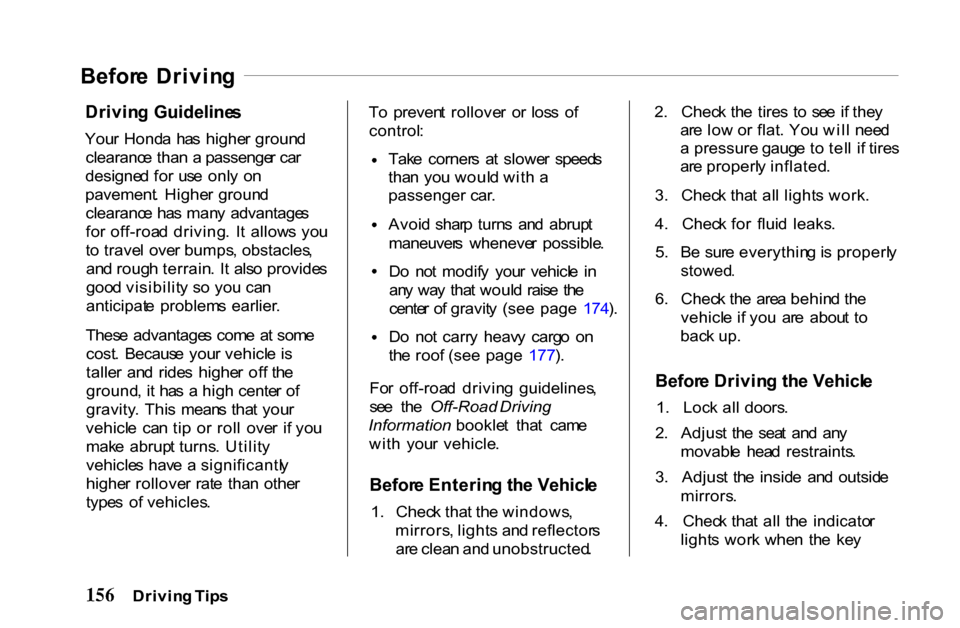
Befor
e Drivin g
Drivin g Guideline s
You r Hond a ha s highe r groun d
clearanc e tha n a passenge r ca r
designe d fo r us e onl y o n
pavement . Highe r groun d
clearanc e ha s man y advantage s
fo r off-roa d driving . I t allow s yo u
t o trave l ove r bumps , obstacles ,
an d roug h terrain . It als o provide s
goo d visibilit y s o yo u ca n
anticipat e problem s earlier .
Thes e advantage s com e a t som e
cost . Becaus e you r vehicl e is
talle r an d ride s highe r of f th e
ground , i t ha s a hig h cente r o f
gravity . Thi s mean s tha t you r
vehicl e ca n ti p o r rol l ove r i f yo u
mak e abrup t turns . Utilit y
vehicle s hav e a significantl y
highe r rollove r rat e tha n othe r
type s o f vehicles . T
o preven t rollove r o r los s o f
control :
Tak e corner s a t slowe r speed s
tha n yo u woul d wit h a
passenger car .
Avoi d shar p turn s an d abrup t
maneuver s wheneve r possible .
D o no t modif y you r vehicl e i n
an y wa y tha t woul d rais e th e
cente r o f gravit y (see page 174 ).
D o no t carr y heav y carg o o n
th e roo f (see page 177 ).
Fo r off-roa d drivin g guidelines ,
se e th e Off-Road Driving
Information booklet tha t cam e
wit h you r vehicle .
Befor e Enterin g th e Vehicl e
1 . Chec k tha t th e windows ,
mirrors , light s an d reflector s
ar e clea n an d unobstructed .2
. Chec k th e tire s t o se e i f the y
ar e lo w o r flat . Yo u wil l nee d
a pressure gaug e t o tel l i f tire s
ar e properl y inflated .
3 . Chec k tha t al l light s work .
4 . Chec k fo r flui d leaks .
5 . B e sur e everythin g is properl y
stowed .
6 . Chec k th e are a behin d th e
vehicl e i f yo u ar e abou t t o
bac k up .
Befor e Drivin g th e Vehicl e
1 . Loc k al l doors .
2 . Adjus t th e sea t an d an y
movabl e hea d restraints .
3 . Adjus t th e insid e an d outsid e
mirrors .
4 . Chec k tha t al l th e indicato r
light s wor k whe n th e ke y
Drivin g Tip s